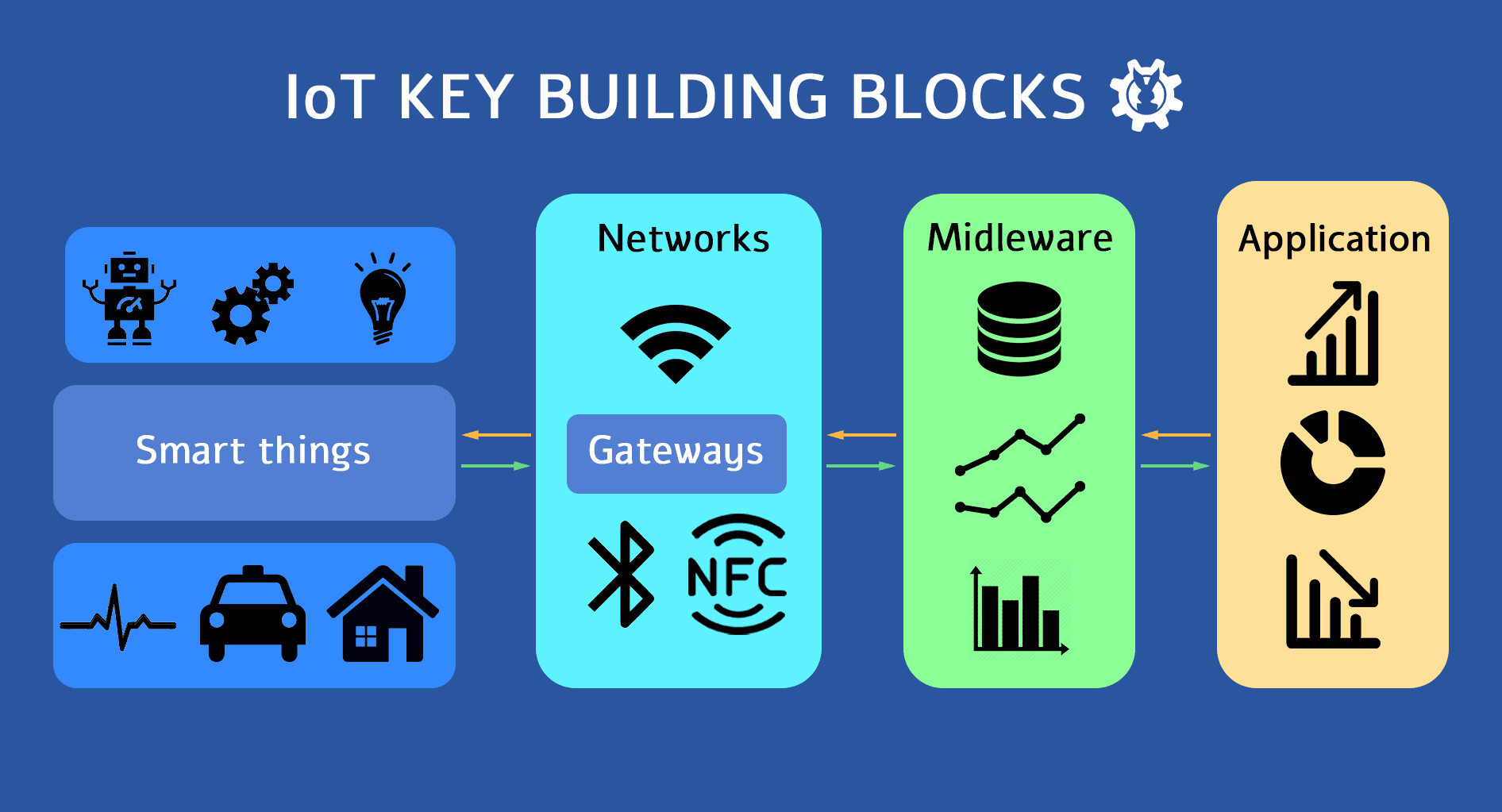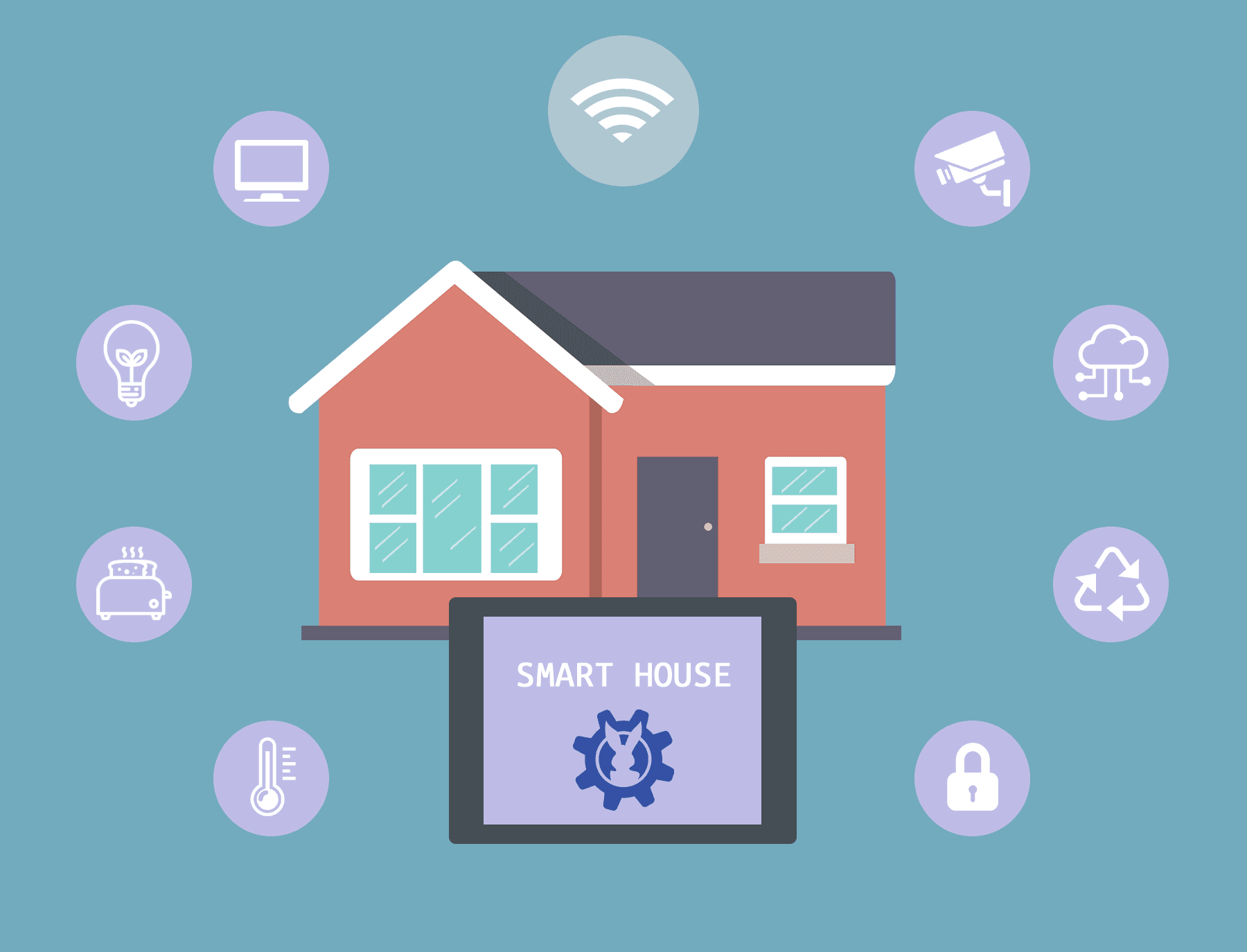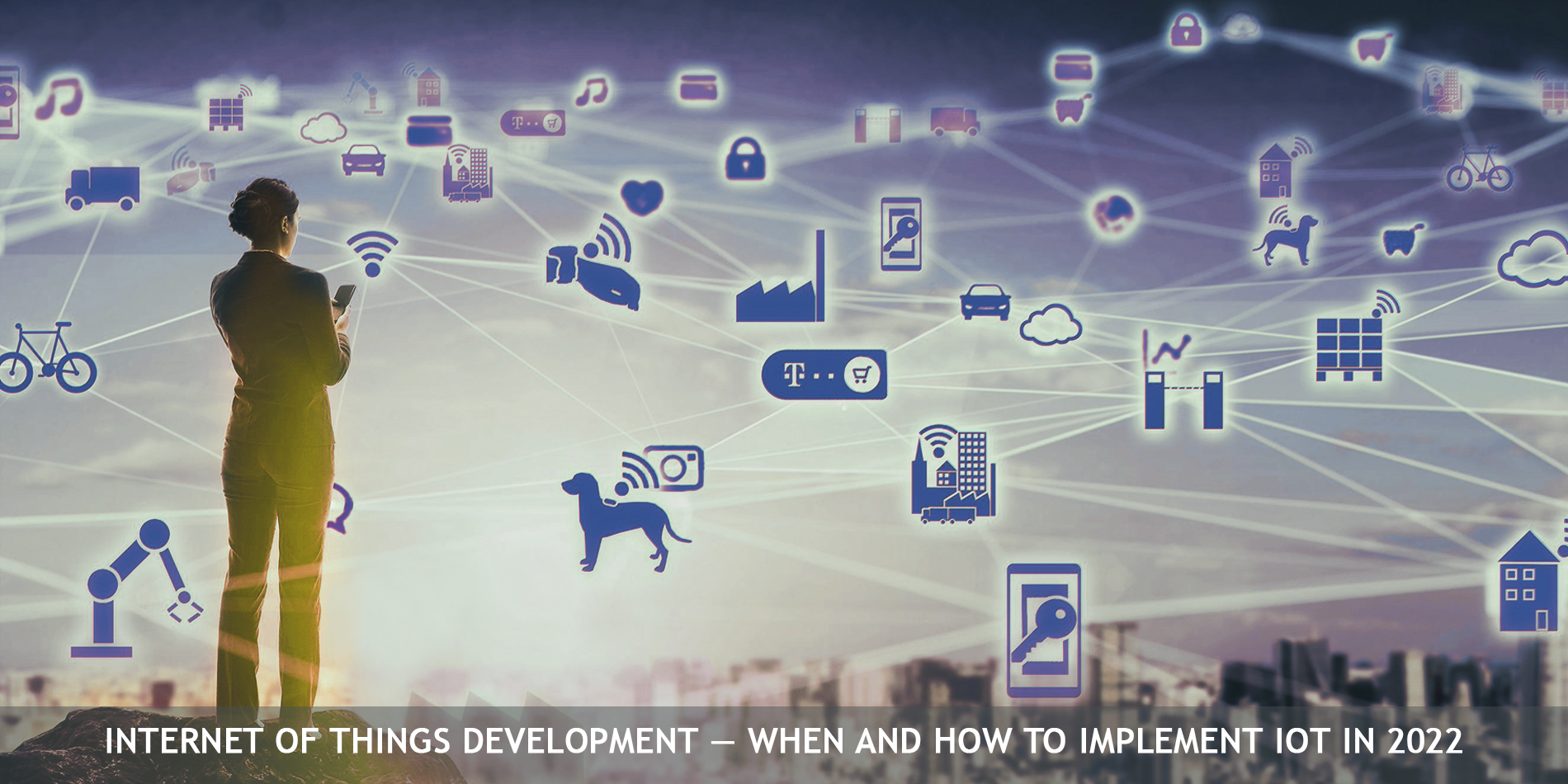People have talked about the Internet of Things for a long time and, mostly, in complimentary terms: a new branch of development, limitless possibilities, the next big thing. Feels like total digitalization is about to cover everything from doorbells to traffic lights. The number of IoT devices already exceeds 12 billion units and may exceed 41 billion by 2025. In this article, we will share our thoughts regarding the IoT perspectives and answer the questions of when and how to implement the Internet of Things in 2022.
IoT meaning — What is the Internet of Things
The Internet of Things is a system that connects real things to a virtual network. Thanks to this technology, the efficiency of the work increases, and human intervention is almost reduced. With simple processors and wireless networks, anything from a tablet to a self-driving car can be incorporated into the Internet of Things (IoT). This process adds a level of digital intelligence to devices that can transmit data in real-time without human intervention, effectively merging the digital and physical worlds.
The architecture of IoT devices is quite simple. To work, the devices must recognize each other, receive information from the environment, have a network to communicate with each other, and a computer that will process all these operations.
The devices recognize each other thanks to infrared tags or QR codes, which allow each device to have its own name. Information from the environment is obtained thanks to various sensors, Bluetooth, and Wi-Fi. Even a small built-in computer can handle this.
The implementation of IoT requires an ecosystem: gadgets with sensors, access and information transmission network, platforms for network, device, and application management.
There are several standards for data transmission:
- eMTC (enhanced Machine-Type Communication) standard is deployed based on LTE mobile networks,
- EC-GSM-IoT (Extended Coverage - GSM - Internet of Things) works on top of the GSM network.
- NB-IoT (Narrowband IoT) standard. It can be deployed both in GSM or LTE networks and in a separate network.
All IoT projects are divided into two groups:
- Massive MTC
- Critical MTC
Each type has its own tasks and network requirements. The Massive IoT projects include smart homes, truck tracking solutions, and agriculture. It is the transfer of a small amount of data from many sensors. If for some reason, the information was not received, the data will be updated during the next transfer session. For mass projects, devices need to be cheap and consume little energy. Some of these projects can be implemented based on GSM networks, but most of them are built on the basis of LTE infrastructure.

Industries and Projects for IoT Development
IoT has many advantages and is slowly integrating into everyday life. Smart cities and industrial IoT segments are two of the most promising IoT projects. The supply chain, connected buildings and cars, the energy sector, and connected buildings are all areas of the potential use of IoT. These projects are increasing by more than 30% annually in the EU, while the number in the US is much lower.
Here are some examples of the Internet of Things use.
Smart home (intelligent building, smart-house, digital home)

You can control almost all the processes of the house remotely. For example, to save energy, you can set a timer to turn on the heating an hour before you wake up or return home. A coffee maker knows when you wake up and brews the coffee at the exact time. The house independently records how much energy was used this month, so you don’t need to make any calculations. Smart elevators notify of malfunctions, while the refrigerator notifies a smartphone that it has run out of products.
Internet of things in Healthcare
The Internet of things allows for solving existing problems in Healthcare. The IoT solutions improve the efficiency of treatment and patient monitoring. The most popular cases of IoT use for healthcare purposes include:
- Remote monitoring of patients
- Hospital operations management
- Glucose monitoring can minimize the risk of death from diabetes
- Сonnected inhaler to prevent an asthma attack
- IoT-based hearing aid application
- A blood coagulation test helps keep the patient's activity within the therapeutic range to reduce the risk factor.
- Smartwatches for the level of depression
- Detecting cancer with IoT devices
- Monitoring of patients with Parkinson's
- Monitors to check the patient's medication time
- Robotic surgery
- Control of hand hygiene
- Effective drug management
- GPS smart sole
- Body scan for fitness purposes
- Management of medical waste
- Heart rate monitoring
Smart city
In recent years, city administrations have been actively implementing municipal programs designed to increase the level of safety and comfort. An ideal Smart City is a city where all physical services and systems are combined into one network using information and communication technologies. All essential processes for a smart city are monitored using sensors and controlled remotely: for example, you can monitor the condition of street lights in real-time, manage the degree of their illumination, monitor the consumption of utility services, and respond to accidents in time, monitor air quality and safety on the streets and control the level of emissions, regulate traffic, occupancy of parking lots and much more. It makes cities more convenient and safer. And the collection of big data based on sensors helps local authorities better understand the city's and its residents' needs.
Smart transport
With the advent of smart cities, cars are also connected to the Internet. They can independently assess the situation on the road or write a message if there is insufficient fuel to get to work, the battery dies, or the tire pressure jumps. A self-driving car can even take you to work or home when needed.
Possible IoT Automations for Business
IoT technologies are beneficial for business: it is easier to prevent breakdowns than to spend money on repairs and replace manual labor with automated ones. In business, the Internet of Things is used in almost all areas and helps to automate most of the processes.
Logistics
Tracking routes and laying paths, monitoring the state of transport, calculating profitable ways and times of cargo delivery. The Internet of Things technology began precisely with the optimization of logistics.
Production
Sensors in factories or agricultural farms monitor the condition of equipment, crops, livestock, and soil, and the platform monitors processes with minimal human involvement. Process automation means speeding up, optimizing costs, and increasing profits.
Storage of goods
Sensors and smart devices monitor the state of warehouses in automatic mode: storage conditions, occupancy level, and more. Proper storage reduces the number of spoiled goods and waste, and losses.
Marketing
The Internet of Things provides invaluable benefits for product evaluation from the point of view of the customer's user experience. It results in the collection and analysis of data about the audience, its behavioral habits, and preferences to create a portrait of the buyer and determine the criteria for the probability of selling a certain product at the right time.
Retail
Points of sale can quickly communicate with warehouses and deliver the necessary goods, transmit data about the demand for products and make requests. The Internet of Things increases profitability, decreases costs, optimizes business processes, improves the buyer's user experience, increases engagement, and makes production safe for employees and the environment.
Top IoT Tools and Platforms
The IoT platform is the framework that ties together the major parts of the IoT architecture. You can develop your own solution or use one of the existing ones. There are numerous IoT development solutions, so choosing the best tool is often confusing. Here is a brief overview of some of the most relevant tools and platforms.
- ThingWorx
- Eclipse IoT
- DeviceHive
- Kaa
- Node-RED
- Arduino
- Flutter
- Kinoma
- Tessel 2
- M2MLabs Mainspring
- Raspberry Pi OS (ex. Raspbian)
- Eclipse IoT
- SiteWhere
- Home Assistant
- OpenRemote
- ThingsBoard
- Milesight DeviceHub
- Zetta
ThingWorx
ThingWorx is a platform that allows programmers and other customers to create countless solutions for smart connected operations and products in medicine, industry, and manufacturing. This resource provides IoT-leading capabilities for industrial organizations that enable more efficient business models and business growth.
You can leverage data from connected products at minimal cost, increasing productivity and enterprise efficiency. ThingWorx makes it possible to securely implement services, products, and operations, being a reliable and flexible tool that constantly improves the quality of service to its customers.
Eclipse IoT
It is one of the most useful development tools for IoT developed by the joint efforts of several specialists from different fields. With its help, you can create frameworks, get implementations with open source code, provide services that help in the use of IoT solutions, as well as create tools for developers in this area.
It has proven itself as a tool that provides high-quality services affordably and predictably. It is an amazing development tool, the benefits of which have already been appreciated by many.
Device Hive
Device Hive is also an open tool that helps you connect devices to your application and add objects. Devices are connected via WebSocket, REST API, or MQTT. The platform supports several programming languages, which makes it universal for all devices.
It also allows participants to discuss development or business and offers promising approaches to creating software for commercial purposes. You can monitor the device connectivity without using network configuration. You can also quickly conduct analytics in a way that is convenient for you, getting the world's best data solutions.
Kaa
It is one of the most flexible and extensible platforms that allow both creating IoT solutions and managing connected devices. It offers a rich set of capabilities, including data collection and processing, analytics, configuration management, data visualization, and more. Kaa supports open IoT protocols and provides total security for user information. It gives you complete control over your devices, and you can choose the hosting option that suits you, whether it's a public cloud or local private servers.
With its help, you can connect and control devices using graphical UPI or REST API. The creators of Kaa, having a wealth of experience in this area, invested in it the ability to serve all known spheres of life, including various corporations and smaller startups.
Node-Red
This tool is gaining increasing popularity in the world of technology and the Internet of Things. Node-Red is a very flexible and useful open-source visual editor that allows developers of all levels to establish connections between cloud systems, databases, APIs, and more.
It can also work on low-budget machines, including inexpensive cloud solutions and Raspberry Pi. This tool consists of 225,000 modules, which makes it easy to expand the palette of nodes to add new features. Node-Red was developed by IBM, so with the help of this editor, you can create Java functions, which in the end can be saved for later use, as well as templates and streams.
How to choose an IoT Solution Specialist
Building an IoT product, think of your potential user. To avoid many mistakes, answer the following questions:
- What problems should your development solve?
- What actions do you want to simplify for your users?
- It is essential to conduct research and business analysis of the problem, the experience of solving similar competitors' problems, and the users themselves. It will allow you to understand how people will use your product.
When choosing an IoT solution specialist, it’s essential to consider some things:
Knowledge of BigData technologies - it is crucial for developers to understand how the processes of receiving, processing, and storing data work.
Ability to work with cloud services - for an IoT application, you need to choose a secure platform and be able to configure and deploy it.
Experience in cybersecurity - ensure your contractor knows how to protect the IoT system. Otherwise, it will be vulnerable.
IoT Application Support - any application needs post-release support, especially regarding data security.
If you want to develop an IoT application, choose reliable vendors who have experience with IoT technologies and successful cases. Remember about users - the product should solve the problem. Start with an MVP, and when you collect the first feedback, you will understand whether it is worth developing the product and adding new features.
If you feel interested to know more about IoT solutions, let's talk and see how we can help you specifically for your business needs.




